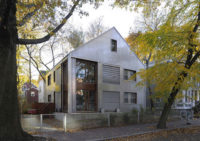One Window House
One Window House, an anti-McMansion in a tight spot.
Architects & Firms
Venice, California
In the fight against McMansions, Venice, California, firm Touraine Richmond Architects’ One Window House serves as a demonstration project. Technically an addition to a 1950s home, the residence measures only 1,500 square feet and fits on a tight urban site in Venice. Yet it feels about twice that size, thanks both to the architects’ skillful maneuvering around building codes and their maximization of space, light, and natural surroundings in the project.

Additional Content:
Jump to credits & specificationsArchitects Olivier Touraine and Deborah Richmond, AIA, live with their toddler in the steel-and-wood-framed house, which they completed in 2005. After securing the 5,600-square-foot site in 2002, just a few yards from their old house (which they now use as offices for their five-person firm), the couple—accustomed to living in tight urban locations in Paris, Rotterdam, and Osaka—didn’t want (nor could they afford) anything too large. “I can’t imagine how people live in 6,000-square-foot houses,” remarks Touraine. “They need cell phones to call each other. Some people say too much is not enough. I think too much is too much.”
Due to the tight site, made even more cramped by local regulations that forced the architects to allow for several parking spaces they didn’t need (“I think the zoning rules were written by General Motors,” quips Touraine), there was little room to build out. So they decided to build up. The house rises three stories, clad with large expanses of clear glass, polycarbonate, and corrugated-metal panels that shift between horizontal and vertical planes. To address restrictions that require sloping roofs for buildings over two stories, the topmost portion of the house’s east facade takes a sharp incline, which follows the path of the polycarbonate-clad stairway inside. All these elements give the facade its memorable, varied composition of alternating horizontals and verticals, levels and diagonals, and solids, translucents, and transparents.
Further regulations called for 5-to-15-foot setbacks away from the street and neighboring houses, limiting space further. The architects took advantage of this by planting lush native vegetation on all sides. They also maximized usable outdoor living space, creating a patio, a courtyard, and dramatic balconies on upper floors. “The border of the house does not bind the space,” says Touraine. “It extends to the view. I love the ability to see far away.”
The lofty, open-plan first floor enhances the connection with the outside through large, clear windows, sliding doors, and high ceilings. Yet despite all the exposure to light, the house stays cool thanks to cross ventilation, shade from surrounding vegetation, and curtains lined with Mylar that reflect heat and glare. Rather than being designed with a checklist of sustainable add-ons, says Touraine, the house is passively green.
CreditsArchitect: Deborah Richmond, AIA, and Olivier Touraine, DPLG, Principals Engineer(s):
General contractor:
Photographer(s): |
SpecificationsStructural system: Exterior cladding: Windows: Glazing: Skylights: Insulated-panel or plastic glazing: Doors: Wood doors: Sliding doors: Hardware: Interior finishes: Paints and stains: Curtains: Svensson: Countertops: Bathroom floor tile: Floors: Furnishings: Tables: Upholstery: Lighting: Task lighting: Plumbing: Sinks: Fixtures: Shower/bath fixtures: Tub/Showers: Accessories: Add any additional building components or special equipment that made a significant contribution to this project: Fireplace: Kitchen appliances: |



